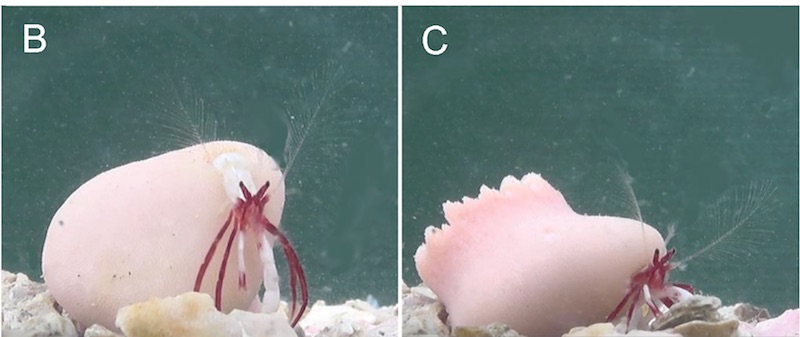Walking Dendros are still fairly new to the reefing hobby, only being introduced as recently as 2009. The coral is Heteropsammia cochlea, a substrate-dwelling yet photosynthetic stony coral that gains its “walking” title by way of a Sipunculan (Peanut worm,) that lives burrowed inside it. The coral larvae settle on a snail shell with the worm already underneath it. The coral skeleton grows and envelops the shell over time and the worm with it, but the worm excavates a hole in the underside of the coral with which it can extend out to feed, but also move the coral polyp at a reasonable speed to find food once it smells it, hence the walking. They can be kept in aquaria and are occasionally offered for sale. They make good talking points as much as anything.
Then underwater photographer iwashiiwashi on Instagram photographed what looks like Heteropsammia cochlea, only with a filter-feeding Hermit crab dwelling inside the Peanut Worm’s hole. The crab is even newer, only being described in 2017, by Momoko Igawa and Makoto Kato in the peer-reviewed journal PLOS ONE and is called Diogenes heteropsammicola. We covered the new crab at the time but it’s great to see fresh pictures.

“Symbiont shift is rare in obligate mutualisms because both the partners are reciprocally dependent on and specialized to each other,” the authors state in the paper’s abstract. “In the obligate accommodation–transportation mutualism between walking corals and sipunculans, however, an unusual saltatory symbiont shift was discovered. In shallow waters of southern Japan, an undescribed hermit crab species was found living in corallums of solitary scleractinian corals of the genera Heterocyathus and Heteropsammia, replacing the usual sipunculan symbiont.”
“We described the hermit crab as a new species Diogenes heteropsammicola (Decapoda, Anomura, Diogenidae), and explored its association with the walking corals. This hermit crab species obligately inhabits the coiled cavity of the corals, and was easily distinguished from other congeneric species by the exceedingly slender chelipeds and ambulatory legs, and the symmetrical telson. Observations of behavior in aquaria showed that the new hermit crab, like the sipunculan, carries the host coral and prevents the coral from being buried. This is an interesting case in which an organism phylogenetically distant from Sipuncula takes over the symbiotic role in association with a walking coral. The hermit crab species is unique in that its lodging is a living solitary coral that grows with the hermit crab in an accommodation–transportation mutualism.”
Hermit crabs inhabit other invertebrates too. Staghorn Antler hermit crabs inhabit the hydrocoral Janaria mirabilis and Paguritta spp. crabs occupy the Christmas tree worm tubes in Porites corals. Whether the peanut worm had died or vacated its Heteropsammia host is unclear. We see our “reef-safe,” hermit crabs kill, eat and inhabit snails in our tanks although Diogenes heteropsammicola looks altogether more spindly and delicate. Either way, we’ll never tire of mutualism in the marine world.




